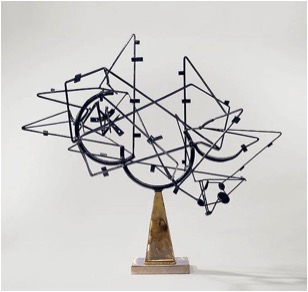
Star Cage, 1950
David Smith
Star Cage, 1950
Painted and brushed steel
114 x 130.2 x 65.4 cm
The Frederick R. Weisman Art Museum, University of
Minnesota, Minneapolis.
The John Rood Sculpture Collection.
© The Estate of David Smith, VAGA, New York / VEGAP, Bilbao, 2016
“If you ask why I make sculpture, I must answer that it is my way of life, my balance, and my justification for being.” David Smith, 1947–52[1]
After finishing high school, 19-year-old David Smith (Decatur, Indiana, 1906–Bennington, Vermont, 1965) worked as a riveter and welder at a car factory, where he learned how to handle metalworking tools. But his true passion was art, and in 1926 he moved to New York to study at the Art Students League. There, encouraged by his teachers, Smith began to incorporate three-dimensional materials in his paintings, creating collages and reliefs. These added elements grew increasingly voluminous and protuberant, and eventually the canvas became a mere base and his paintings were transformed into sculptures[2].
In 1929, Smith was impressed when he saw several reproductions of Pablo Picasso's iron sculptures in the magazine Cahiers d'art. This marked a radical turning point in his work: he abandoned the traditional notion that a sculpture should be modeled or carved around a central mass, and instead began using found objects like Picasso. With them he created a network of intersecting lines and planes which define a hollow space at the heart of each piece[3]. Smith assembled his structures of welded metal and found materials using a forge and anvil as well as an oxyacetylene torch, producing what were probably the first welded-metal sculptures made in the United States[4]. The artist used metal, which for him represented progress and industrialization, in both his figurative and abstract work[5]. Although Abstract Expressionism is generally considered a pictorial movement, there were some sculptors who defied the traditional conventions of sculptural practice and can be included in this group. Smith was one of those few sculptors.
In April 1950 Smith was awarded a Guggenheim Fellowship, which freed him from teaching and from other side jobs. He could also afford the materials to make larger scale works, thus marking the beginning of a very productive period. That same year he created Star Cage, a sculpture defined by the sharp contrast between its effortlessly flowing organic form and the rigid industrial material of which it is constructed: steel. Smith wanted his works to be "drawings in space". Star Cage is a sculpture that blurs the boundaries between two- and three-dimensionality. The work is constructed of manipulated steel rods that trace lines in space, dynamically angled and notched at the intersections. The interconnected rods, arranged as vertical and horizontal planes, activate the space and prompt the viewer to gaze through the work, making empty space an integral part of the piece.
Smith wanted his sculpture to be seen as something active, a changing, ever shifting space created by the viewers as they circle the work, gaze through and around it, and generate negative and positive spatial relationships[6]. The work does not offer a single, dominant, frontal view, but a shifting sequence of possibilities that allows it to be contemplated from different angles, expanding and contracting as the spectator examines it in the round. Star Cage generates a game of lines and planes that suggest a starry constellation, an abstract model of mysterious clumps of elements which could be read as molecules or astral bodies[7]. In his work, Smith reflects the complexity of stars which, when seen in the night sky, seem to be arranged on a flat plane. Taking inspiration from the cosmos, the artist chose the most suitable material and method for capturing these awe-inspiring constellations[8].
Preguntas
Observe the sculpture Star Cage. What do you see? What terms would you use to describe it? Can you explain its shape? What’s the first thing you notice about this work?
Star Cage is made of painted and brushed steel. What do you associate with steel? What properties does that material have? What qualities does it suggest to you? Which methods do you think the artist used to make it? Describe the steps he followed. Why do you think he decided to paint part of the sculpture?
For Smith, steel represented progress and industrialization. Why do you think he chose this material? What do you think he was trying to say through this work? Instead of carving or sculpting his works according to the conventions of three-dimensional art at the time, Smith decided to weld several pieces. What are the advantages and drawbacks to his way of working?
Smith worked with welded steel to produce what he called “drawings in space”[9]. How do you think drawing and sculpture are related? Do you think Smith managed to draw space in his work? How?
